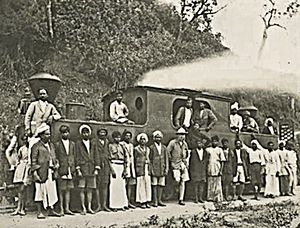Kundale Valley Light Railway
The Kundale Valley Light Railway was first a privately owned monorail system by the 'Kanan Devan Hills Plantations Company'(KDHP & Co) that operated in Kundale Valley, near Munnar in Kerala to serve the tea plantations in the area. [1] [2] The monorail operated from 1902-1908
In 1908 the line was converted to a 2 ft(610 mm) (NG) narrow gauge railway.
The Kundale Valley Light Railway, also referred to as the Kanan Devan Railway also the Munnar Light Railway , was a major transportation facility in the area till 1924, when a flood wrought havoc on the system and restoration of the railway was considered impossible. Wikipedia use the title Kundala Valley Railway, this appears to be the modern spelling [3]
History
Monorail (1902–1908)

Kundala Valley Railway Monorail was built in 1902 and operated between Munnar and Top Station in the Kannan Devan Hills of Kerala . This railway was built to transport tea and other goods. Initially a cart road was cut in 1902, then later replaced by a monorail goods carriage system along the road leading from Munnar to 'Top Station' for the purpose of transporting tea and other products from Munnar and Madupatty to 'Top Station'. This monorail was based on the Ewing System and had a small wheel placed on the track while a larger wheel rested on the road to balance the monorail. This was similar to the ‘Patiala State Monorail Trainways’. The monorail was pulled by bullocks. 'Top Station' was a trans-shipment point for delivery of tea from Munnar to Bodinayakkanur. Tea chests arriving at 'Top Station' from the Kundala Valley were then transported by an aerial ropeway from 'Top Station' 5 km (3 miles) down hill to the south to Kottagudi, Tamil Nadu, which popularly became known as 'Bottom Station'. The tea was shipped 15 km (9 mi) by cart to Bodinayakkanur, then by rail to other places in India and by ship to England.
The report in 1903 only one year into its 6-year use [3] was not very complementary. The construction of the road was along the Kundale Road a distance of 22 miles (35.5Km) from Madupatty (Mattupetti) to Top Station; with a stop at Palaar which was the rest point for the bullocks overnight. 'They pulled at 2 miles an hour up a twisting 1 in 40 incline with a maximum gradient of 1 in 30. The weight of the trucks was 12 cwt carrying one ton. Whilst the track was easy to lay they used a lot of the 13 feet (4 Meter) roadway, the road weaves its way around the hills and when the out rigger is on the road side make passing nearly impossible, passing places are then required or reversing stations to keep the out rigger on the outside of the road. The roadway for the out rigger must be kept smooth or the wheel will shake its self apart. On sharp curves the flanges tend to grind and extra power is needed to pull them around the bend. If the bend is too sharp and the cart travelling to fast it will come of the track so it is much better suited for straight and more level lines' [4] The monorail lasted 8 years before being replaced with a narrow-gauge railway.
Narrow gauge railway (1908–1924)

The 2 ft(610 mm) narrow gauge (NG) railway was a 20 mile(32 km) line constructed in 1908 to replace the Monorail from Munnar to 'Top Station'. Opened 1908 by the ‘Kanan Devan Hills Plantations Company’ (KDHP & Co) to serve the tea plantations in the area. The railway was a major transportation facility in the area till 1924, when a flood wrought havoc on the system and restoration of the railway was considered impossible [5].
Finally the entire project was dismantled.
Further Reading
- “Facets of A Hundred Years’ Planting,” an in-house publication of Tata-Finlay Ltd, says that it took one-and-a-half years to complete the railway project for which the parts of the train were shipped from Britain and assembled at Munnar by engineers of the British tea company. Four railway stations were built for the project at different places including Munnar. The book has a number of black and white photographs. When the railway was dismantled, a network of rope-ways was built in Munnar for speedy transportation of tea leaves and other goods, says the book [6]
- “Industrial Railways and Locomotives of India and South Asia” compiled by Simon Darvil, provides more details of the locomotives, rail alignments and ropeway systems [7].
References
- ↑ "Kundale Valley Light Railway:"; Retrieved 12 Dec 2015
- ↑ IRFCA "Railways other than IR in India""; Retrieved 12 Dec 2015
- ↑ 3.0 3.1 Wikipedia "Kundale Valley Railway"; Retrieved 125 Oct 2020
- ↑ British Library IOR/ L/MIL/7/14846 Memorandum 11114 1903
- ↑ "Munnar Light Railway - Then and Now"; Retrieved 12 Dec 2015
- ↑ "Facets of A Hundred Years’ Planting – A Centuary of Tea Planting in the Kanan Deven Hills” published by Tata-Finlay Ltd, 1978 by Baig, Amita; Henderson, William.
- ↑ “Industrial Railways and Locomotives of India and South Asia” compiled by Simon Darvill. Published by ‘The Industrial Railway Society’ 2013. ISBN 978 1 901556 82-7. Available at http://irsshop.co.uk/India. Reference: Entry KL12. page ....